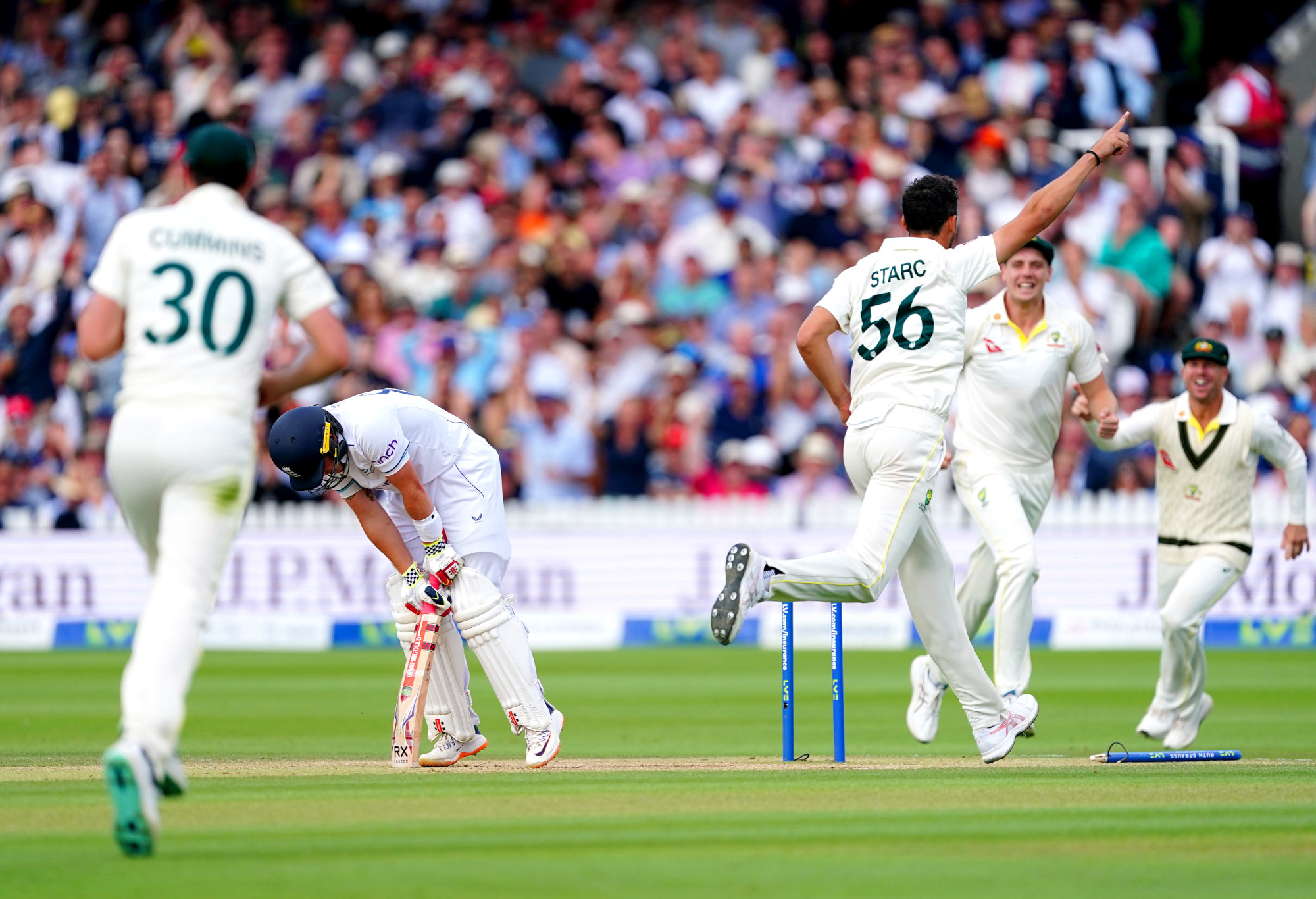The short-pitched barrage adopted by both teams in this Ashes series has prompted fears it could start mirroring the controversial 1932-33 Bodyline series.
Batters have been battered on either side as Ben Stokes and Pat Cummins have instructed their fellow fast bowlers to dig the ball in short to stem the run rate with defensive field settings.
They have also put several fielders in the deep and in catching positions close to the bat on the leg side to pounce on any shots not guided to ground.
In the UK Telegraph, Scyld Berry and Will McPherson wrote that 98% of England’s deliveries were short of a length in the afternoon session of day four of the second Test at Lord’s.
“We should expect to see plenty more of it in this series, which could become the Bodyline of our time,” they wrote.

Mitchell Starc celebrates after bowling Ollie Pope. (Photo by Mike Egerton/PA Images via Getty Images)
“The leg-side boundary riders are the new cordon.
“It is not Test cricket at its most attractive. Boundaries become desperately hard to come by, because the field is so well set. The over rate slips even further behind than usual (England ended the match with a rate of -8.5, almost guaranteeing that they will be fined and docked World Test Championship points again).”
Former England captain Nasser Hussain was scathing in his assessment of the bowling tactics.
“That session of almost non-stop short-pitched bowling from England on Saturday afternoon was unlike anything I have ever seen before in Test cricket. Together with the morning it was an unbelievable passage of play. At times it was farcical. It was certainly surreal,” Hussain wrote in the Daily Mail.
“Spells of bouncers and individual short-pitched duels between fast bowlers and batters have always been part of the game but this was different.
“Ninety eight per cent of all deliveries in the middle session of the fourth day at Lord’s were short and we went two hours before a single ball was pitched up.”
Hussain added: “So, was England’s approach in the field contrary to their vow to entertain? Well, at times it was incredibly dull on Saturday because spectators knew what ball was going to be delivered and where the batters were going to hit it.
It was a mundane policy, yes, but I liked it because it took a hell of a lot of effort and it was successful for England, at least until it was their turn to bat again.”
While the tactic has been effective for England, it’s not a great strategy for their veteran seamer, James Anderson.
The 40-year-old prefers to pitch the ball up to let it swing instead of banging it into the turf, which requires much more effort each spell.
It could lead to his retirement, according to Simon Hughes in The Times.
“All this will spell the end for Anderson. More than once at critical junctures in this series other bowlers have been preferred, and he has struggled to make any impact even when conditions should have been to his liking,” Hughes opined.
“Most noticeably, Anderson has failed to produce his original calling card, the late outswinger. That delivery – the ball that angles into the right hander and then ducks wickedly away – has been the basis of his game, generating a high proportion of his 686 Test wickets.”
Lawrence Booth, in the Daily Mail, went on a similar theme.
“Critics of Bazball have joked that it feels blasphemous to criticise Ben Stokes’s England, but an even more heretical thought is creeping up on us. How much more will we get to see of Jimmy Anderson?” Booth wrote.
“On the fourth day of this bizarre second Ashes Test, the answer was: not very much. And it wasn’t simply because England spent the afternoon answering Australia’s short-ball barrage with one of their own, a sledgehammer tactic at odds with Anderson’s scalpel.”
With England 4-114 heading into the final day chasing an unlikely target of 371, the odds are stacked against them.
But England batting coach Marcus Trescothick said while Stokes is at the crease, anything is possible, as he proved with his 2019 Miracle of Headingley century to pull off a remarkable one-wicket win.
“We know the history, don’t we?” said Trescothick on BBC Sport. “We’ve talked many times about Headingley and other occasions when he’s held it together.
“While Ben is there, with Ben Duckett, Jonny Bairstow and the tailenders, we’re still pretty hopeful.
“It’s finely balanced. We’ve got a big job to do. We didn’t want to lose the wickets at the top order but we faced some beautiful balls, it’s not out of the question yet. Whatever happens tomorrow, it’s going to be an exciting final day.”
Meanwhile, Nathan Lyon’s act of bravery, to come out to bat despite a calf injury, failed to impress former England captain Andrew Strauss.
“It begs the question, what’s the point?” Strauss asked on Sky Sports commentary.
“He’s not going to be able to run any singles.
“It’s all very well showing bravery getting out there, but if you can’t score a run, it’s utterly pointless.
“This just seems foolhardy to me … this is a guy’s career potentially on the line here.
“Australia will argue that any runs these two make will be runs that England have to get, and it’s therefore worthwhile … it’s painful to watch though, I must admit.”





























































































